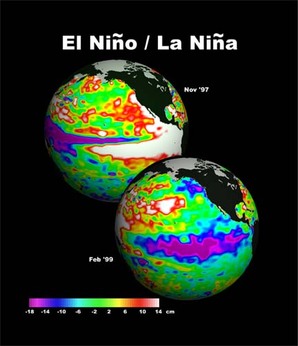12.11: Short-term Climate Changes
- Page ID
- 12868

Short-term changes in climate are common. The largest and most important of these is the oscillation between El Niño and La Niña conditions. This cycle is called the ENSO (El Niño southern oscillation). The ENSO drives changes in climate that are felt around the world about every two to seven years.
In a normal year, the trade winds blow across the Pacific Ocean near the equator from east to west (toward Asia). A low pressure cell rises above the western equatorial Pacific. Warm water in the western Pacific Ocean and raises sea levels by one-half meter. Along the western coast of South America, the Peru Current carries cold water northward, and then westward along the equator with the trade winds. Upwelling brings cold, nutrient-rich waters from the deep sea.
In an El Niño year, when water temperature reaches around 28 degrees C (82 degrees F), the trade winds weaken or reverse direction and blow east (toward South America). Warm water is dragged back across the Pacific Ocean and piles up off the west coast of South America. With warm, low-density water at the surface, upwelling stops. Without upwelling, nutrients are scarce and plankton populations decline. Since plankton form the base of the food web, fish cannot find food, and fish numbers decrease as well. All the animals that eat fish, including birds and humans, are affected by the decline in fish.
By altering atmospheric and oceanic circulation, El Niño events change global climate patterns.
- Some regions receive more than average rainfall, including the west coast of North and South America, the southern United States, and Western Europe.
- Drought occurs in other parts of South America, the western Pacific, southern and northern Africa, and southern Europe.
An El Niño cycle lasts one to two years. Often normal circulation patterns resume. Sometimes circulation patterns bounce back quickly and extremely, called La Niña.
In a La Niña year, as in a normal year, trade winds moves from east to west and warm water piles up in the western Pacific Ocean. Ocean temperatures along coastal South America are colder than normal (instead of warmer, as in El Niño). Cold water reaches farther into the western Pacific than normal.
Other important oscillations are smaller and have a local, rather than global, effect. The North Atlantic Oscillation mostly alters climate in Europe. The Mediterranean also goes through cycles, varying between being dry at some times, and warm and wet at others.
- Dynamic Earth: Introduction to Physical Geography. Authored by: R. Adam Dastrup. Located at: http://www.opengeography.org/physical-geography.html. Project: Open Geography Education. License: CC BY-SA: Attribution-ShareAlike
- El Nino - La Nina. Authored by: Keith Meldahl. Located at: https://youtu.be/tyPq86yM_Ic. License: All Rights Reserved. License Terms: Standard YouTube License
- El Nino Weather Pattern. Authored by: Intelecom Learning. Located at: https://youtu.be/7FVZrw7bk1w. License: All Rights Reserved. License Terms: Standard YouTube License
- El Nino vs La Nina Sea Level Anomalies. Provided by: NOAA. Located at: https://www.ncdc.noaa.gov/teleconnections/enso/enso-tech.php. License: Public Domain: No Known Copyright



